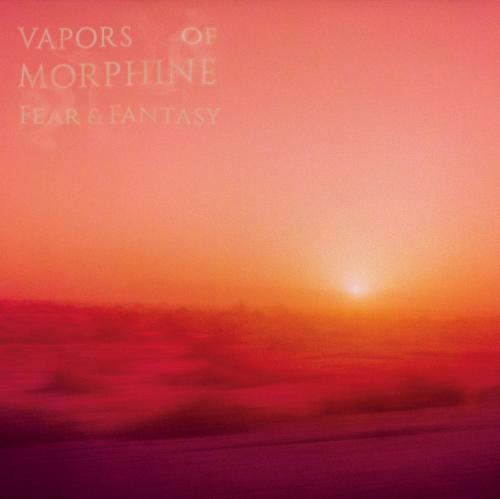Band: Vapors Of Morphine
Album: Fear & Fantasy
VÖ: 24.09.21 Digital | 15.10.21 Physisch
Label/Vertrieb: Schnitzel Records / Rough Trade
Webseite: http://www.vaporsofmorphine.com
Dana Colley is the last remaining original member of the critically acclaimed trio Morphine to continue performing with the offshoot group Vapors of Morphine, which has by now outlived its predecessor and moves in new directions. The 59-year-old Colley’s baritone sax is the through-line that carries from Morphine’s inception in 1989, past the on-stage death of front man and songwriter Mark Sandman in 1999 and into Vapors’ current lineup and sound with Jeremy Lyons and Tom Arey. (All three surviving Morphine members, including drummers Billy Conway and Jerome Deupree played in post-Morphine bands for ten years before Jeremy Lyons showed up, and the trio of Vapors of Morphine was formed, originally with Deupree, occasionally with Conway or others filling in.)
Mark Sandman-- his smoky crooning, gently ominous two-string slide bass and elliptical lyrics -- remains a very real member of Vapors of Morphine, the band that carried forward. Colley might be the last original member, but he’s hardly the last one influencing.
This much is clear on the new Vapors of Morphine album, Fear & Fantasy. Colley’s virtuoso baritone sax remains a load-bearing pillar, as does the two-string slide bass. But now it is played by singer songwriter Lyons who, since he first picked it up in 2009, clearly has turned it into both homage to Sandman and his very own thing.
Initially joined by original drummer Jerome Deupree, and then replaced by Tom Arey, Vapors’ new disc flows with the unique Morphine sound and pulls in sonic expansion courtesy of Lyons, Arey and Deupree.
The album’s A side – called the “Jerome Side” by the band because that’s the collection of songs Deupree played on before dropping out of the project – pushes into the unusual right away, with the ambient noise lead-in to the album, on Lyons’ “Blue Dream.” From there, the album slips into a more familiar, Morphine-like foggy nightscape, with Colley’s “Golden Hour” and “Irene” and “No Sleep” by Lyons.
On the B Side – called the “Tom Side” – the album travels into new places, splicing Morphine roots into a cover of Ali Farka Toure’s “Lasidan” and Lyons’ own New Orleans blues-influenced “Dropout Mambo.” Then Sandman makes a return of sorts – like he ever left – with a Vapors cover of “Doreen,” a song he wrote while in the group Treat Her Right before forming Morphine with Colley.
From there, Lyons, 51, again stamps his mark on Fear & Fantasy with “Ostrich,” and before taking the band out and into Mali with a cover of “Baba Drame” by legend Boubacar Traoré. For fans of Morphine, Fear & Fantasy is alternately familiar and foreign, like returning home in a dream and finding the expected all there, but in new settings and color.
Both Colley and Lyons say that the third Vapors record was difficult to put together. For Colley, the project for years proved elusive and nearly impossible to anchor as a singular priority. “Life has other distractions,” he says. “Creating headspace is difficult to find.”
Plus, he says, even after all these years and so much music, songwriting remains difficult. “It’s never been easy for me,” he admits.
And as for Lyons, he shares those feelings but also carries this added burden: the thrill and ever-present weight of Mark Sandman. For the first Vapors album – then called Members of Morphine – Lyons built and learned the two-string slide base. He pushed his voice into the lower, flatter Sandman octave.
And two decades later – it’s now a full 22 years after Sandman had a massive heart attack on stage in Palestrina, Italy -- for the third Vapors album, Lyons still finds the process taxing and deeply rewarding.
“Stepping into somebody else’s role is a strange and different experience,” he admits. “It’s not easy. But I love what we’ve created.”
The pair point to each other's contributions as their favorite parts of the record. Colley selected “No Sleep” as one of his favorites, and Lyons tagged Colley’s “Golden Hour.”
Colley says he’s never felt solely anchored to Morphine’s considerable history and influence. It was, after all, a band that wasn’t often compared to other bands. With such a distinct sound – it was once described by The New York Times as sounding like, “soundtracks written for pulp-fiction novels” -- Morphine became a descriptor for other bands seeking similar territory.
Colley said he isn’t trying to run from that past any more than he is trying to run toward it. “Those songs are great songs,” he says. Moreover, they still provide way points for his journey forward.
“Playing the music is important to me because I feel very close to it. I was a part of creating it and I want to keep it alive. But I don’t necessarily feel any responsibility to hold onto anyone else’s preconceptions whatever they may be.”
On this much, he and Lyons agree. The band has a deep fidelity to its past while always pushing into new areas. Such is the case with Fear & Fantasy, Lyons says. Vapors of Morphine is not inclined to stand pat.
Colley says “Life, like a good band, doesn’t give a person that choice.”
“Lives change. People die. People quit. People decide to do other things with their lives. You just pick up the day, see what’s in front of you and try to make the most of whatever opportunities you have.”
“Musically speaking, we approach everything on a day-to-day basis. We’re not trying to be the arbiters of the Morphine sound. This is who we are as people and what we sound like together.”
And that sound, both agree, is immensely satisfying. Even so, there was a time when neither were so sure about this album.
As the music lay fallow for the past few years in a digital deep sleep, Colley wondered about releasing it at all. The idea of streaming new music on the internet wasn’t tangible enough to be magnetic to him. For a band whose sound always had an ethereal quality, digital was too ephemeral.
Colley says playing an album is a distinct, tactile relationship. Sliding the record out of the jacket. Setting it on the turntable for the A side. Flipping it over for the B. A listener is much more involved. And in fact, that possibility is what finally pushed Vapors to bring this project in.
“The idea of having it come out on vinyl definitely sparked more enthusiasm,” Colley says. “I’m happy and pleased that its together and that it’s a good record.”
“Besides,” he jokes, “have you ever tried to roll a joint on a digital platform?”


